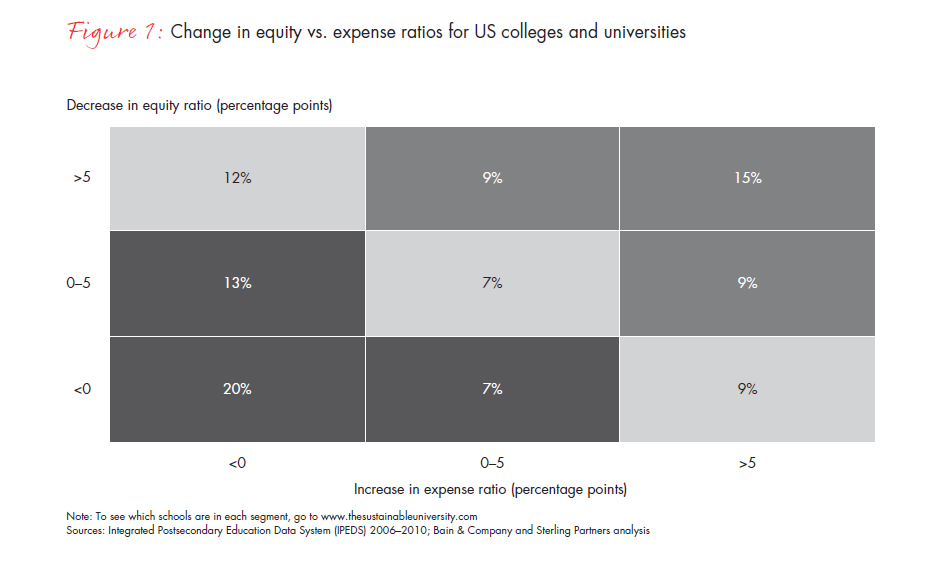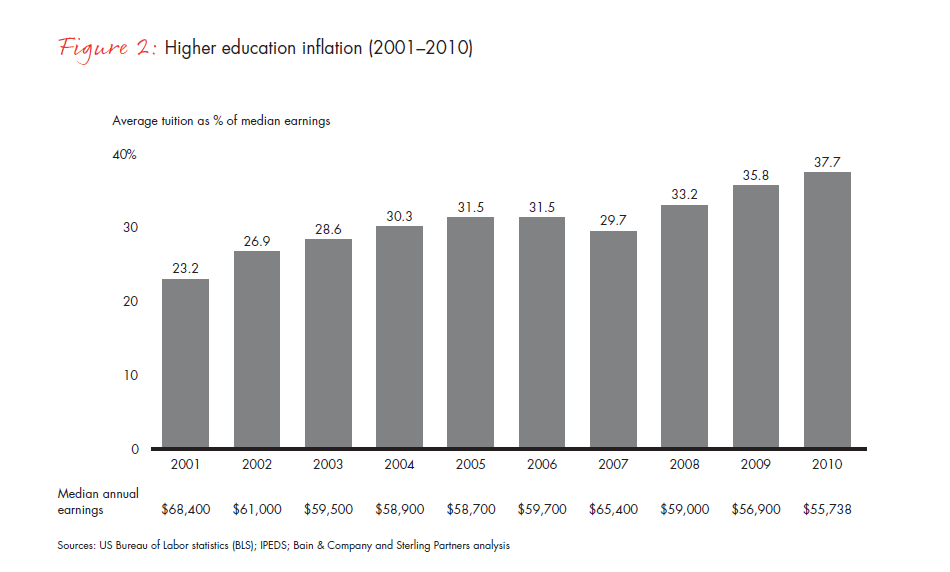Brief

Few industries in the United States have achieved unquestioned global leadership as consistently and effectively as our higher education system. US colleges and universities are the cornerstone of our economic prosperity and the key to realizing the American dream. Thirty years of growth have confirmed the sector’s leadership and vibrancy—the result of demographic and economic factors combining to lift higher education even higher.

The Financially Sustainable University: The Lost Decade
One-third of universities face an unsustainable financial future. Those that survive must take action now to prepare for the future.
Despite this success, talk of a higher education “bubble” has reached a fever pitch in the last year. The numbers are very familiar by now: Annual tuition increases several times the rate of inflation have become commonplace. The volume of student loan debt has surpassed $1 trillion and is now greater than credit card debt. Most college and university presidents, as well as their boards, executive teams and faculty members, are well aware that a host of factors have made innovation and change necessary.
Still, at the majority of institutions, the pace of change is slower than it needs to be. Plenty of hurdles exist, including the belief that things will return to the way they always were. (Note: They won’t.) But the biggest obstacle is more fundamental: While leaders might have a sense of what needs to be done, they may not know how to achieve the required degree of change that will allow their institution not just to survive, but also thrive with a focused strategy and a sustainable financial base.
Leading change is challenging in any organization. But in higher education, it’s markedly more difficult. If the stakes weren’t so high, incremental improvements might be enough. But they aren’t, and that’s become abundantly clear. Change is needed, and it’s needed now. What follows is a road map for college and university presidents and boards of trustees, explaining the scope and depth of the situation, the key actions required and—most important— what it will take to succeed in leading change.
The liquidity crisis facing higher education
If you are the president of a college or university that is not among the elites and does not have an endowment in the billions, chances are cash is becoming increasingly scarce—unless you’re among the most innovative. The reason is simple: Approximately one-third of all colleges and universities have financial statements that are significantly weaker than they were several years ago (see Figure 1).
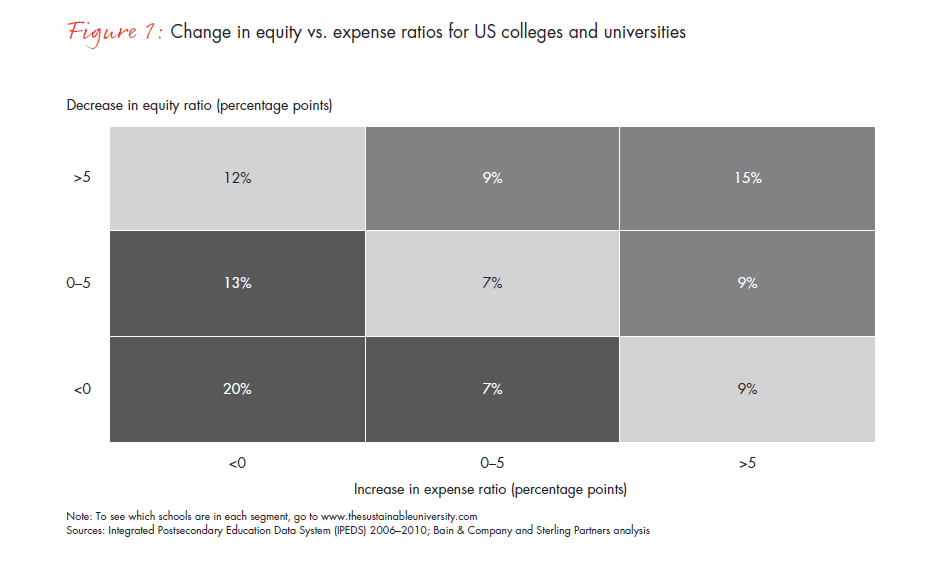
On the balance sheet side, the equity ratio (equity as a percentage of assets) is down—sometimes way down.1 On the income statement side, the expense ratio (expenses as a percentage of revenue) is significantly up.2 And, to make matters worse, endowments have taken a major hit and are not likely to see the type of year-over-year growth they were accustomed to seeing in the decade before the recession.
The translation: Institutions have more liabilities, higher debt service and increasing expense without the revenue or the cash reserves to back them up.
In the past, colleges and universities tackled this problem by passing on additional costs to students and their families, or by getting more support from state and federal sources. Because those parties had the ability and the willingness to pay, they did (see Figure 2). But the recession has left families with stagnant incomes, substantially reduced home equity, smaller nest eggs and anxiety about job security. Regardless of whether or not families are willing to pay, they are no longer able to foot the ever-increasing bill, and state and federal sources can no longer make up the difference (see Figure 3).
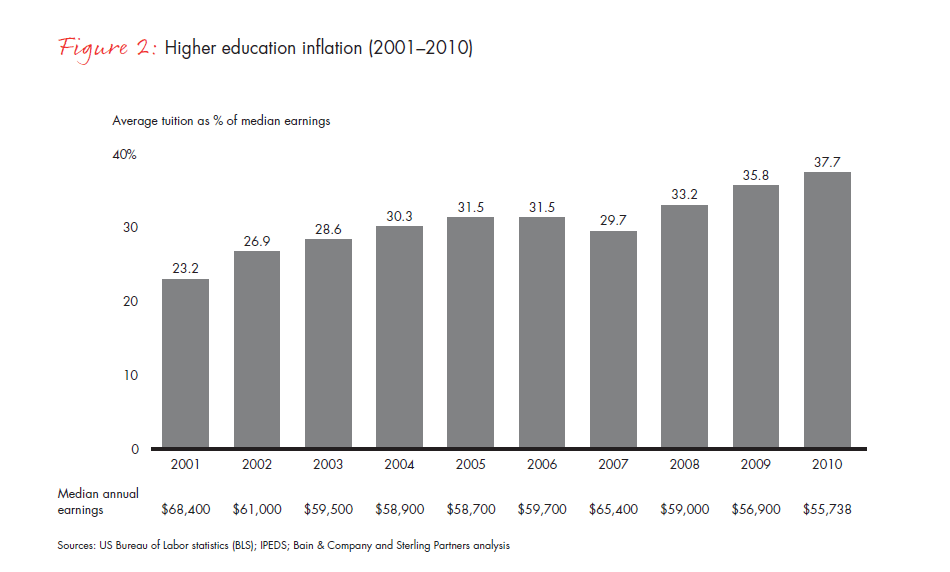
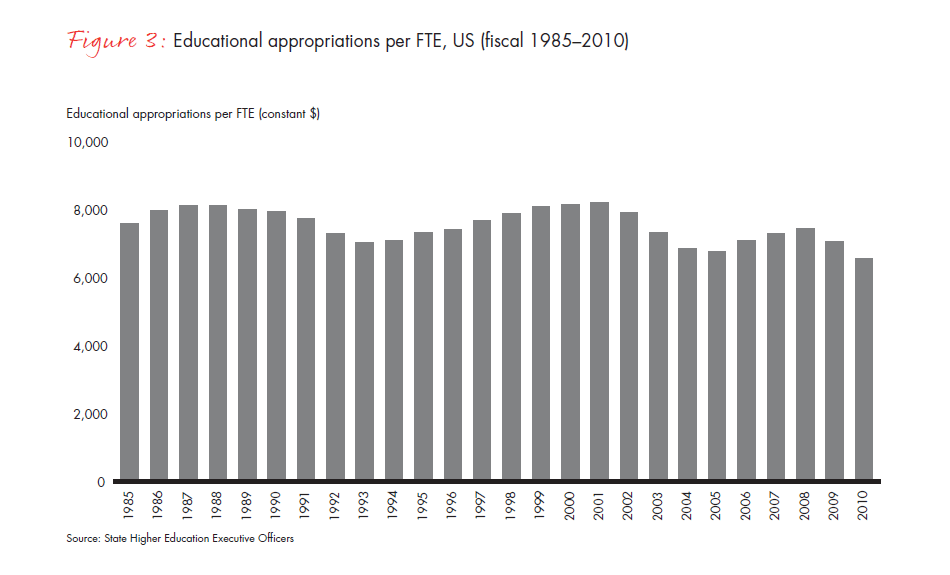
Which institutions are at risk?
Presidents who want to give their institution a stress test can simply refer to the list of questions below. From a financial perspective, highly selective institutions don’t need to worry because they possess pricing power (although they may be concerned that their mission will suffer if they must make compromises to the need-blind admissions policy). Well-endowed institutions or those with strong financial statements through prudent financial management are also fine, because they have ample resources to serve as “shock absorbers.”
You might be at risk if…
Answers to these three questions can tell you if your school might be in trouble.
But what about the others? The data is clear: A growing percentage of our colleges and universities are in real financial trouble. And if the current trends continue, we will see a higher education system that will no longer be able to meet the diverse needs of the US student population in 20 years (see Figure 4).
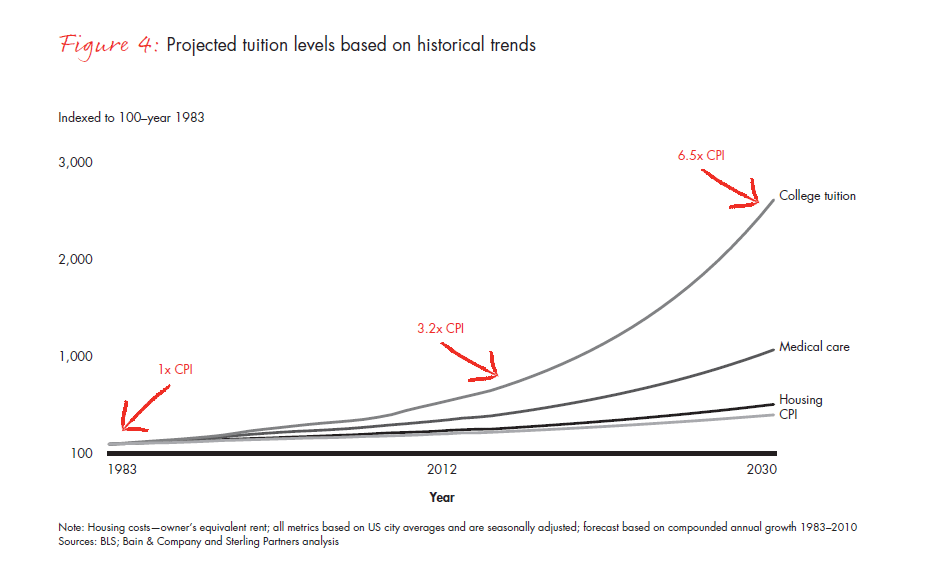
The social and economic implications of that are staggering.
Reversing the “Law of More”
Much of the liquidity crisis facing higher education comes from having succumbed to the “Law of More.” Many institutions have operated on the assumption that the more they build, spend, diversify and expand, the more they will persist and prosper. But instead, the opposite has happened: Institutions have become overleveraged. Their long-term debt is increasing at an average rate of approximately 12% per year, and their average annual interest expense is growing at almost twice the rate of their instruction-related expense (see Figure 5). In addition to growing debt, administrative and student services costs are growing faster than instructional costs. And fixed costs and overhead consume a growing share of the pie (see Figure 6).
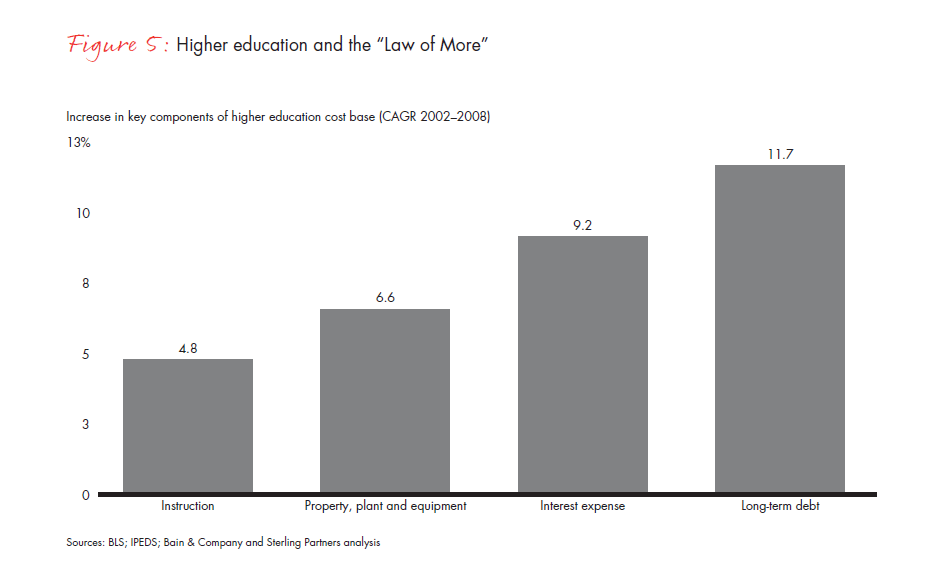
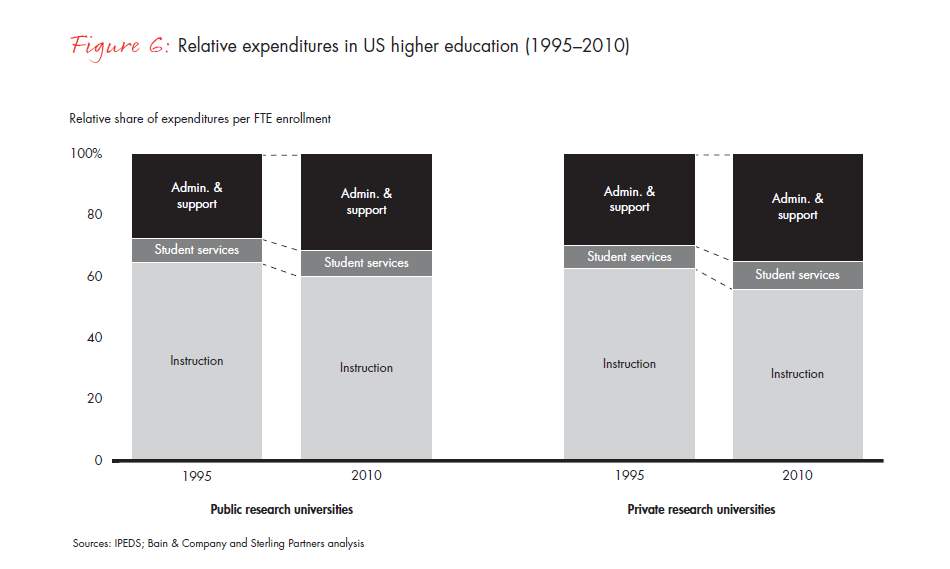
This cost growth is at odds with the concept of the experience curve, which holds true in almost every industry. The experience curve indicates that as a company’s or an industry’s cumulative output goes up, cost per unit of production will go down. A prime example of this is “Moore’s Law,” the principle that the number of transistors on a computer chip will double approximately every two years. The semiconductor industry has maintained this pace for decades, leading to consistent increases in computing power and cost reductions for the technology that is at the heart of the digital revolution.
The natural question for higher education, then, is what incremental value is being provided for the incremental cost?
To reverse the Law of More and create a more differentiated and financially sustainable institution, innovative college and university presidents are doing four things:
- Developing a clear strategy, focused on the core
- Reducing support and administrative costs
- Freeing up capital in non-core assets
- Strategically investing in innovative models
You might think you’re doing many of those things through your strategic planning process, but too often that is not the case. Colleges and universities frequently aspire to be the same thing, with a focus on moving up to the next level and gaining greater prestige. It can be far more about “me-too” as opposed to carving out a unique strategic position. As a result, most of the strategic planning that happens in higher education is on the margins and not focused on making the hard decisions that will ultimately lead to success.
Focusing on the core
The healthiest organizations—from Fortune 500 companies to start-ups to academic institutions—operate with a discipline that allows them to stay true to their core business. The core is where high-performing institutions invest the most and generate the greatest returns. It is the area where they are the clearest about the value they add. It is the domain where they are the most differentiated and the place from which they derive their identity. In short, the core is the strategic anchor for the focused company or the focused university.
In any industry, there are three primary paths to competitive advantage: differentiation, low cost or structural advantage. The trick in pursuing a differentiation strategy is truly understanding your unique core and then focusing resources on it. An implicit part of having a focused strategy is not only defining what you are going to invest in, but also clearly articulating what you are not going to do. If institutions try to pursue too many areas of differentiation, they’re likely to invest too broadly and, thus, reduce the return on investment for precious capital.
We recognize that focusing on the core is hard to do, given the history and culture of universities—authority is often diffuse and people don’t like to say “no,” especially in the absence of any definition of value. But the worst-case scenario for an institution is to be relatively expensive and completely undifferentiated. Who will pay $40,000 per year to go to a school that is completely undistinguished on any dimension?
Unfortunately, many institutions seem to be headed down that path. But by focusing on the characteristics that are truly distinctive and channeling resources to them, institutions can positively improve their performance and get on the path to long-term sustainability.
Reducing support and administrative costs
Boards of trustees and presidents need to put their collective foot down on the growth of support and administrative costs. Those costs have grown faster than the cost of instruction across most campuses. In no other industry would overhead costs be allowed to grow at this rate—executives would lose their jobs.
As colleges and universities look to areas where they can make cuts and achieve efficiencies, they should start farthest from the core of teaching and research. Cut from the outside in, and build from the inside out.
Growth in programs and research, increasing faculty and student demands, and increasingly cumbersome compliance requirements have all contributed to the growth of administrative costs. The reasons are often very legitimate.
But as new programs are added, old programs often are not curtailed or closed down. The resulting breadth of campus activities creates too much complexity for staff to manage with any efficiencies of scale. Units don’t trust one another or the center to provide services, and incentives are not aligned across the campus. These issues ultimately manifest themselves in multiple ways:
- Fragmentation. Data center management is a good example of fragmentation on campus. At the University of North Carolina at Chapel Hill (UNC), the central IT group managed fewer than half of the servers on campus in its data center. For the servers located in the colleges, fewer than half were managed by college IT groups—the rest were considered “hidden” at the department or faculty level. Despite the inherent data and security risk of having so many unmanaged servers on campus, faculty members were very skeptical about turning over control to the university’s central IT department. In similar cases, outsourcing data centers would be a good solution. Third-party data centers, whether they are managed or cloud-based, could provide more sophisticated solutions, higher levels of security, greater flexibility in capacity and lower cost than internal solutions— all with greater accountability and less politics.
- Redundancy. At the University of California at Berkeley, as on many other campuses, procurement was managed at the department level. There were no product standards, and each department negotiated its own vendor contracts. A sample of purchase orders showed that the same item was being bought for as much as 36% more in some departments than in others. By centralizing and standardizing more of its procurement going forward, Berkeley expects to save more than $25 million per year.
- Unneeded hierarchy. Most campuses have too many middle managers. Before it reorganized, Berkeley had average spans of control (the number of employees reporting directly to a manager) of around four, compared with more than six for average companies and closer to 10 for best practice companies. Fixing spans and layers, as well as better defining roles, empowers an organization, reduces bureaucracy and significantly boosts productivity.
- Misaligned incentives. Unlike the corporate world, where profit and share price (mixed with a pinch of anxiety about pay and job security) ultimately help create alignment, there are fewer mechanisms within a university to improve alignment across the campus. Universities tend to operate as a federation of colleges, and colleges as a federation of departments. Budget models are complex and the flow of funds convoluted. The people who manage budgets often have limited options to influence the entities responsible for consumption and, ultimately, costs (e.g., many campuses don’t charge departments for electric power based on consumption). Despite a culture of openness, there is surprisingly little transparency because data is poor, silos are strong and performance management is virtually nonexistent.
- Complexity. Simply put, campuses engage in too many activities that require too broad a skill set to effectively deliver in-house. Take IT application management, for example. Not only does it need to support classroom and research needs across a diverse set of disciplines (history, music, law, engineering, biomedical sciences), it also has to cover functions (finance, HR, research administration, registrar, libraries, student services). If that weren’t enough, IT also has to serve industries beyond the core academics, including bookstores, retail food, debit cards, hotels, museums, stadiums, publishing houses, veterinary hospitals and power plants. A single IT group would have a hard time managing all of that well, given the expertise required, leading to either poor service delivery or fragmented, subscale and costly delivery.
Outsourcing more of the non-core activities would reduce campus complexity and cost. Third-party providers typically have greater scale capability and skill because the outsourced service is their core business, enabling them to deliver the same or better service at a lower cost.
Ultimately, in order to reduce administrative costs without diminishing service—and perhaps even enhancing it— campuses will need to consolidate subscale operations by creating shared services or outsourcing; improve processes by eliminating low-value work and automating more; refresh the organization by streamlining spans and layers and improving performance management; and strengthen controls by updating the budget model, modifying policies and increasing transparency.
Freeing up capital in non-core assets
Another significant opportunity for institutions to strengthen their cash position is to better manage their assets. Whether it is real estate, physical assets or intellectual property, colleges and universities are involved in a number of activities where partnerships with thirdparty providers would allow for financial relief and improved performance.
Real estate
US colleges and universities collectively have more than $250 billion worth of real estate assets on their balance sheets. In other real estate–intensive industries, such as lodging, restaurant and healthcare, organizations have consistently found ways to turn a portion of these assets into cash by selling and leasing back, without losing their ability to use the real estate in the same way as before. At some colleges and universities, real estate represents the single largest asset on their balance sheet. The former president of a large land grant institution in the Pacific Northwest expressed one of his biggest frustrations during his tenure: He had been sitting on $2 billion worth of real estate assets, but he hadn’t had the opportunity to use any of it to improve his university’s financial situation. Converting even a small portion of an institution’s real estate assets to cash could change its strategic trajectory.
Physical assets
Many institutions own other physical assets that could also be converted to cash through sale and leaseback arrangements or outsourced service contracts. In most IT outsourcing deals, for example, the service provider buys the client’s IT assets (infrastructure, equipment, facilities and so on) up front and then provides service on a long-term contract.
Hard assets like power plants and cogeneration facilities offer campuses another opportunity to free up capital, as commercial power companies may be interested in acquiring those assets. There is also a growing class of private equity investors looking to infrastructure investments to provide low-risk, stable cash flows to balance out their portfolios. By selling these assets, campuses could free up tens of millions of dollars in capital.
Intellectual property
Many college and university presidents feel that technology transfer offices are the custodians of some of their institution’s most underleveraged assets. Indeed, US colleges and universities spend some $92 billion each year in R&D and realize approximately a $2 billion annual return on those investments. Conversely, intellectual property companies that manage the patent portfolios of technology giants such as Microsoft typically get returns of several times their clients’ original R&D investment. Some of those companies are beginning to look at the higher education sector as an area where they can make a major impact and bring innovative products to market. By partnering with intellectual property companies in the private sector, colleges and universities could tap into a lucrative new source of revenue to strengthen their balance sheets and support other mission-focused organizational activities.
Strategically investing in innovative models
College and university presidents are well aware of the “disruptive innovations” that are changing the landscape within higher education. According to a 2011 survey by the Babson Survey Research Group in collaboration with the College Board, online enrollment grew at a compound annual growth rate of more than 15% per year between fall 2002 and fall 2010, increasing from less than 10% of all higher education enrollments to just more than 30% during that period. A recent Bain survey of 4,500 students also indicates growing online enrollment: Approximately 45% of respondents had taken an online course.
The rapid growth of online education has changed the game in a number of areas: value proposition (flexibility for students), economics (higher fixed-cost percentage, but lower fixed-cost dollars), marketing and recruiting (increasing reach) and outcomes and assessment (better tracking and measurement). Nearly two-thirds of the college and university leaders at more than 2,500 institutions surveyed by the Babson Survey Research Group said that an online strategy is critical to the long-term success of their institution. Yet surprisingly, less than 50% of responding CEOs had included online programs in their campus strategic plan.
There is no question that the online market is rich with opportunity, but until you have defined your core strategy and identified significant capital to invest in creating academic value, you will not survive in the online arena. For some institutions, rushing into the online space too rapidly to grow enrollment and create new revenue is another me-too strategy. There are already too many entrenched players and new entrants with significant capital in the market for an undifferentiated strategy to succeed.
As online courses enter the market and employers begin to accept “badges” and other credentials (further decreasing demand for traditional degrees), the price students will be willing to pay for undifferentiated brands will continue to fall. While this won’t be a problem for elite institutions like Harvard and MIT, it represents a significant challenge for most colleges and universities.
Leading the change necessary to be successful
Creating change on campus is harder than creating change in a corporate setting. In the corporate ecosystem, power resides largely with the executive team and cascades down. In academia, power usually emanates from the faculty and works its way toward the central administration. The concept of shared governance, combined with academic autonomy and tenure, leads to an organization where broad change cannot be mandated. Instead, change on a large scale can only be achieved by working with the faculty to build a compelling case and a clear path forward—one that supports the mission of the institution, but copes effectively with fiscal constraints.
Based on the many conversations we’ve had with campus leaders, it’s clear that they generally know what to do, but really struggle with how to do it. To implement a strategy that allows the organization to focus on the core, reduce costs, outsource and monetize assets, and develop online and lower-cost programs, institutional leaders need to bring key stakeholders on board and be clear about roles and accountability.
Bringing key stakeholders on board
One university chancellor told us, “20% are always going to be on board with me and 20% are always going to oppose, regardless of what the change is. The trick is getting the 60% in the middle to first engage and then buy into the change.”
By nature, faculty members tend to have a low tolerance for business administration and change that disrupts their routines. But most faculty members are also evidence- based decision makers who care deeply about the educational mission of the institution they serve, and this is an area where the president and the faculty can find common ground. There are a few truths that may or may not be self-evident to faculty, but that the president should have ample evidence to support. These truths are 1) there is no status quo; 2) effective change needs to be institution-wide; and 3) budget doesn’t always correlate with value.
There is no status quo
Too often, stakeholders believe that the current cash crunch and need for change is a temporary phenomenon that will subside as the economy continues to improve. But those who see things this way probably haven’t been exposed to the data presented here and in other reports that show convincingly that this time is different. Faculty and other key stakeholders must be shown clear and compelling facts to disprove the “return to the status quo” notion and to clarify the corresponding negative implications and consequences of inaction.
Change needs to be institution-wide
The magnitude of the challenges being addressed is too great and the organization is too complex for changes to be restricted to certain corners of the campus. Scale matters when you are trying to minimize the cost of administrative functions, and few departments or colleges on a campus have enough scale to achieve real benefits. The support of key stakeholders must be elicited across the organization.
At UNC, the central facilities administration spearheaded a clear example of what can be achieved by working together. The project’s goal was to improve classroom utilization in order to accommodate a growing student body without the need to build new buildings or renovate old ones. Based on an analysis of classroom utilization, the current space could meet anticipated demand, with a higher degree of coordination among the departments, the faculty and central administration. Many classrooms on campus had been scheduled and managed at the department level in nonstandard blocks, and some faculty had been starting their classes on the half-hour on days when the format for other classes started on the hour—effectively taking two time slots for a single class. The administration offered an inducement: In exchange for standardizing class schedules and allowing nondepartmental usage of their classrooms, the administration would pay for technology upgrades. It was a win-win situation: The cost of the additional technology was significantly lower than the cost of building new classrooms, and the departments got upgrades they couldn’t have funded from their own budgets. Beyond capital savings, the teamwork and standardization saved the university $800,000 and gave it more flexibility in negotiating its overhead rate with federal grant-making agencies.
In other cases, it may be necessary to apply a set of consequences in order to effect change. Given the scarcity of resources and corresponding competition for those resources, discretionary budget allocations are typically the most effective tool. At one university, the provost provided two budget alternatives to each dean and supervisor. The first was to move forward with the changes suggested by the administration’s “transformation team.” The second offered a flat cut to all units if they did not want to participate in the transformation program. The flat cut in the second alternative was significantly higher than the savings that would be achieved by participating in the transformation. The logic behind this was simple: If any unit abstained, savings would go down for everyone. But by working together across the institution, more could be achieved with less pain.
Budget does not always correlate with value
But working together across the institution does not mean that all campus activities have equal value. Part of a president’s vision for change will need to address where the institution will place priorities that are consistent with its mission and differentiated strategy. For example, in an organization that plans to reduce overall costs, it’s quite possible that some departmental budgets will increase, while less strategic ones will be cut more significantly.
On the administrative side, budget cuts are always perceived as service cuts. Given the way services have been delivered—fragmented and subscale—that’s probably true. But going for greater cost efficiency does not necessarily mean that effectiveness has to decline. Poor operations take longer to perform the same task, require more people to get the work done and tend to have significant quality issues, leading to rework and customer frustration. By building scale operations with the right expertise, process and tools, campuses can reduce cost while actually improving service levels.
On the academic side, given how difficult it is to define and measure value, the underlying rationale supporting academic budgets is rarely called into question. In the normal budgeting process, all departments typically receive what they were awarded the year before, plus a small increase for inflation. This is how one department at a world-class university ended up with a faculty-to-student ratio of greater than five to one, including majors and doctoral students.
Given the concentration of power and autonomy in the individual departments, the tendency within many colleges and universities is simply to assume that all departments should cut equally from their budgets and return those funds to central administration. While this approach is politically defensible as being “fair” and leaves autonomy with the units for deciding how to achieve savings, it is not particularly strategic and creates distorted incentives for managers. In this model, highly effective managers who run lean operations are forced to cut muscle while less effective managers simply trim fat. This leads to a culture where people unnecessarily hoard resources so that they have something to give back when asked.
Another example of budget versus value can be found by looking at Cornell University’s decision to consolidate five different economics departments, which had been spread across multiple schools within the university. All departments were well regarded, but some were stronger than others. When the decision was made to create one top-ranked economics department, some of those departments were essentially eliminated, while others were fortified in the transition. This change enabled Cornell to further its mission and to better serve its students, while also producing significant overall cost savings.
Being clear about roles and accountability
One of the biggest challenges in academia is the lack of alignment and trust that frequently permeates campus environments. There is a perception that departments and units can’t effectively collaborate because they don’t understand one another’s objectives, priorities and needs. The mistrust is compounded by a sense that outcomes aren’t measured appropriately, which leads to a lack of confidence in other departments. All of this contributes to academic units desiring independence and adds to the level of difficulty in driving coordinated institutional change. But this can be corrected by taking needed steps to clarify roles and create a culture of functional and individual accountability.
Role clarity
Several years ago, at one major research university, a plan that made the organization more efficient and saved it money was put in place. Then it was undone. Countless hours and millions of dollars were lost due to a lack of clarity about roles and responsibilities.
For some time, multiple departments at the university had been managing their own unique contract with the same learning management system (LMS) vendor. Each unit had an independent software license, a different software update version, its own server to run the application and an independent employee to manage the system. It was fragmented, redundant and inefficient, but it allowed for independence. Then as part of a campus change initiative, all the departments agreed to have the central IT office manage a single university-wide contract with the vendor. As part of the move, the central office renegotiated a single license, put all units on the same software version, had them share server space and gave a single employee the task of managing the system. The result was significant savings for the university and better operability.
But then things broke down. What hadn’t been made clear during the change was who had ultimate decision-making authority over classroom technology within individual departments. Approximately one year after the change, when central IT informed the departments that the university would be switching LMS vendors, the departments were irate. Feeling that it wasn’t central IT’s call, the departments demanded their individual contracts back—and got them. The savings were erased and trust was eroded. However, if at the outset it had been established which party was being given decision rights over vendor selection, the collaboration would have been much more likely to succeed.
Accountability
While faculty members have incredibly high standards around teaching, research and publishing, which are reinforced through peer review, grading and win rates on grants, they tend not to apply those standards and rigor to the administration in their own departments. Although many of them are quick to point out the flaws of central service providers, they do not recognize the same shortcomings within their own units.
Creating functional accountability is the best solution to breaking down issues of alignment and trust so that institution-wide solutions can be implemented. First, as the LMS example highlighted, it is critical to articulate roles and responsibilities, including decision rights, for each functional unit. Once that is clear, service-level agreements can be negotiated between the functional service provider and the units. These agreements should clearly spell out what level of performance is expected. Finally, service quality dashboards can be created. These dashboards can be broadly published to create transparency about actual operating performance versus agreed-upon goals. This transparency can help overcome suspicion and distrust about how decisions are being made.
Beyond functional accountability is individual accountability. Because of the decentralized nature of colleges and universities, many roles cross functional boundaries. Universities also tend to be culturally averse to providing critical feedback to staff. At one university, of the more than 6,000 performance reviews on file from the prior couple of years, fewer than 10 were rated as not meeting expectations. Based on subsequent interviews with campus managers, it was clear that there were more than 10 underperformers on campus! Colleges and universities can put more rigor behind individual performance management by developing metrics for evaluation that everyone can understand and apply consistently.
Conclusion
The Law of More needs to be overturned. Universities simply cannot afford to increase costs in nonstrategic areas and take on more debt, if they want to survive. It is imperative that universities become much more focused on creating value from their core. That will require having a clear strategy, streamlined operations, a strong financial foundation, trust and accountability, and a willingness to invest only in innovations that truly create value for the institution.
Higher education in the United States is at a tipping point. In its time of need, the leaders of our colleges and universities have a tremendous opportunity to reshape and reinvent an industry that is directly linked to our economic prosperity and the hopes and dreams of millions.
That time is now.
Jeff Denneen leads the Americas Higher Education practice for Bain & Company and is a partner in the Atlanta office. Tom Dretler is an executive in residence with Sterling Partners and is board chair and co-founder of the Alliance for Business Leadership.
The authors would like to thank Jeff Selingo for his contributions to the report. Jeff Selingo frequently writes about higher education and is the author of the forthcoming book College (Un)Bound: The Future of Higher Education and What It Means for Students, due from Amazon Publishing/New Harvest in spring 2013.
You might be at risk if….
- You are not a top-ranked institution
- Your admissions yield has fallen and it’s costing you more to attract students
- Median salaries for your graduates have been flat over a number of years
- Your endowment is in the millions not billions, and a large percentage is restricted
- Your financial statements don’t look as good as they used to
- Your debt expense has been increasing far more rapidly than your instruction expense
- Your property, plant and equipment (PP&E) asset is increasing faster than your revenue
- You have seen a decline in net tuition revenue
- Tuition represents an increasingly greater percentage of your revenue
- Your bond rating has gone down
- You are having trouble accessing the same level of government funding
- You have had to take drastic measures
- You are consistently hiking tuition to the top end of the range
- You have had to lower admissions standards
- You have had to cut back on financial aid
- You have reduced your faculty head count
1 Equity ratio = total net assets (assets – liabilities) divided by total assets
2 The asset ratio is calculated by dividing net assets by total assets and measures the strength of an organization’s balance sheet. Net assets is a term that indicates the remaining assets on an organization’s balance sheet after removing liabilities. The expense ratio is calculated by dividing an organization’s expenses by its revenues and indicates the financial sustainability of a business. Simply put, an organization’s expense ratio is an indication of its ability to cover the expenses endured by cash inflow.
